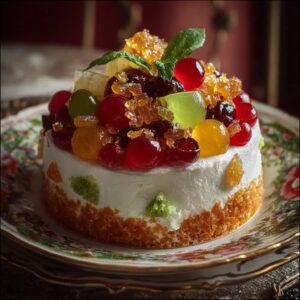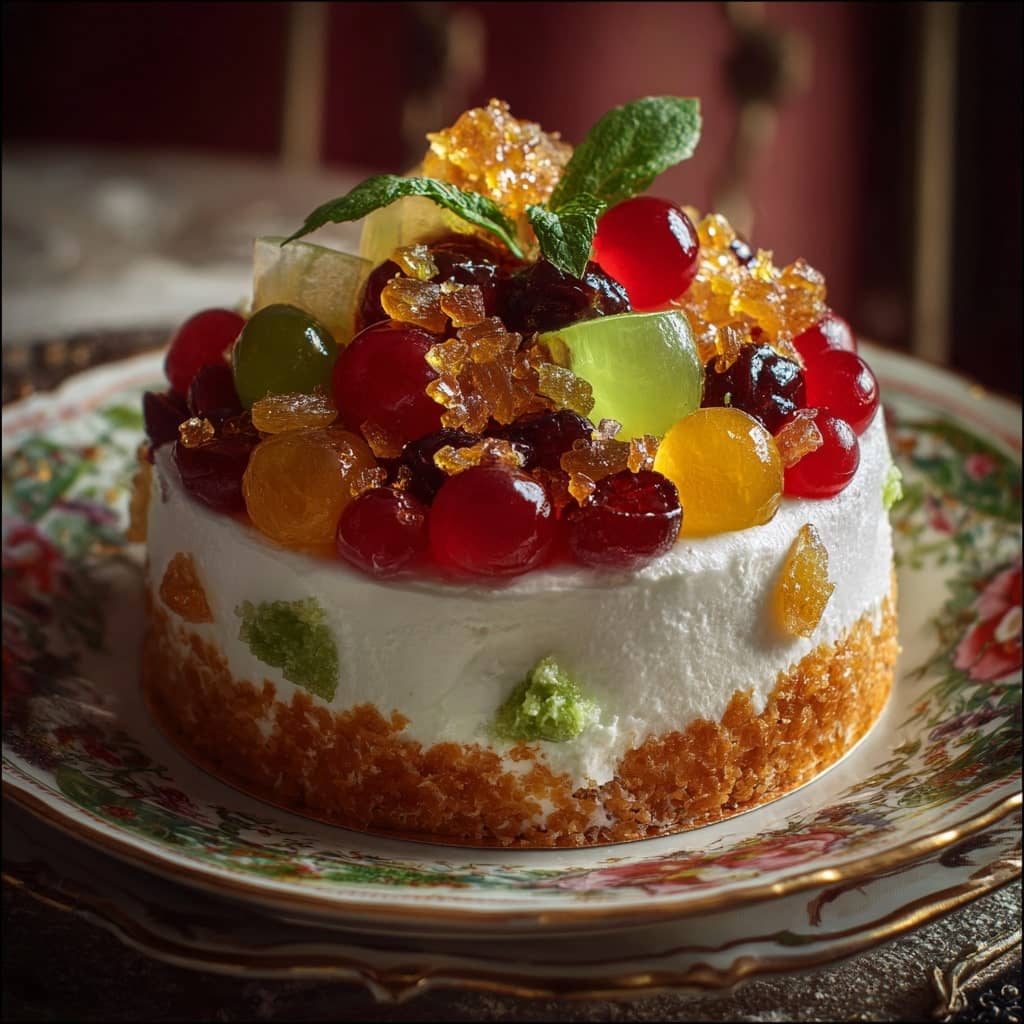The Sicilian Cassata Cake is one of Italy’s most iconic and luxurious desserts, boasting centuries of history, vibrant aesthetics, and rich flavor. A symbol of festivity and tradition, it’s especially prominent during Easter and Christmas in Sicily. The cake is characterized by its colorful decoration of candied fruits, a filling of sweetened ricotta cheese, sponge cake layers soaked in liqueur or fruit syrup, and a vibrant green marzipan shell. Every bite of Cassata is a celebration of Sicily’s culinary crossroads, reflecting influences from Arab, Norman, and Spanish cultures, and encapsulating the island’s love for sweet, layered creations. The word “Cassata” likely comes from the Arabic word “qas’ah,” meaning a bowl used to shape the dessert. It was during Arab rule in the 10th century that ingredients such as sugar, citrus, and almonds were introduced to Sicily—key components that make up the heart of the cassata cake. Originally prepared in monasteries and reserved for noble occasions, it evolved through the Renaissance and Baroque periods, incorporating ever more lavish ingredients and designs. Today, Cassata remains a cultural and culinary gem, passed down through generations of Sicilian families.
Ingredients Breakdown:
- Sponge Cake: 1 large sponge cake or two 9-inch rounds (preferably homemade Genoise or Pan di Spagna)
- Ricotta Filling: 2 lbs (900 g) whole milk ricotta cheese (well-drained), 1 ½ cups (300 g) powdered sugar, 1 tsp vanilla extract, ½ cup (75 g) mini chocolate chips, optional: candied orange peel or chopped pistachios
- Syrup for Soaking: ½ cup (120 ml) water, ½ cup (100 g) sugar, 2 tbsp orange liqueur (such as Grand Marnier or Cointreau)
- Marzipan Layer: 14 oz (400 g) marzipan, green food coloring (traditional), powdered sugar for rolling
- Glaze: 1 cup (120 g) powdered sugar, 2–3 tbsp milk or lemon juice
- Decorations: Assorted candied fruits (orange, lemon, cherries, citron), silver dragées or pistachios for garnish
Step-by-Step Recipe:
- Prepare the Ricotta Filling: Drain the ricotta overnight in a fine mesh sieve or cheesecloth. Beat it with powdered sugar and vanilla extract until smooth and creamy. Fold in the chocolate chips and optional candied peel. Chill until ready to use.
- Prepare the Sponge Cake: If using a whole sponge cake, slice into three even horizontal layers. If using two round cakes, level and halve each to create four thin layers.
- Make the Syrup: In a saucepan, combine sugar and water, bring to a boil, and stir until sugar dissolves. Remove from heat, let cool slightly, and add the orange liqueur.
- Color and Roll Marzipan: Knead green food coloring into marzipan. On a surface dusted with powdered sugar, roll it out to about ¼ inch (6 mm) thick, large enough to cover the sides and base of a springform pan. Line the pan with the marzipan.
- Assemble the Cake: Line the bottom and sides of a springform pan with marzipan. Lay one layer of sponge cake inside, brush generously with syrup, spread with ricotta filling. Repeat layers, finishing with a cake layer on top. Chill the assembled cake for at least 4 hours or overnight.
- Unmold and Glaze: Carefully remove the cake from the pan. Mix the powdered sugar and milk or lemon juice to create a thick but pourable glaze. Spread over the top of the cake.
- Decorate: Arrange candied fruits in patterns, traditionally floral or symmetrical, covering the top entirely. Garnish with chopped pistachios or silver dragées for added sparkle.
Tips for the Perfect Cassata:
Ensure the ricotta is well-drained to avoid a runny filling; fresh sheep’s milk ricotta is ideal but cow’s milk is also fine. Allow the sponge to dry out slightly before assembling, as it absorbs syrup better this way. Let the cake rest overnight before serving for the best flavor and structure. Use high-quality candied fruit; artisanal or homemade varieties taste better than overly sweet commercial kinds. For a clean finish, chill the cake before slicing and wipe the knife between each cut.
Variations and Customizations:
For a more modern twist, substitute the ricotta filling with mascarpone for a smoother, creamier texture. You can also add chopped nuts, such as pistachios or almonds, to the filling for extra crunch. Some versions include a thin layer of dark chocolate ganache between sponge layers. For a lighter version, replace the marzipan with a layer of pistachio mousse or omit it entirely. Mini cassatas can be made for individual servings or party favors. Regional versions in Palermo and Catania vary slightly in presentation and proportions of ingredients.
Health Considerations and Nutritional Value:
Cassata is a rich dessert, high in sugars and fats, primarily due to the ricotta, marzipan, and candied fruits. A standard slice (1/10th of the cake) may contain around 400–500 calories, 20–25 grams of fat, and 40–50 grams of sugar. While it’s not a health food, it offers some protein from ricotta and small amounts of calcium and fiber, especially if you include nuts and fruit. To make it lighter, reduce the sugar in the ricotta, use low-fat dairy alternatives, and opt for fresh fruit instead of candied. It contains gluten and dairy, so it’s not suitable for those with celiac disease or lactose intolerance unless modified.
FAQ:
Can I make Cassata ahead of time? Yes, in fact, it’s best made a day in advance to allow flavors to meld.
Can I freeze it? While not ideal due to texture changes in ricotta and marzipan, it can be frozen tightly wrapped for up to a month. Thaw slowly in the fridge.
What if I can’t find ricotta? You can substitute with well-drained cottage cheese or mascarpone blended with a little cream.
Can I skip the marzipan? Yes, though it’s traditional. You can replace it with a pistachio buttercream or omit entirely.
Is there a non-alcoholic version? Absolutely—just use orange juice or a sugar syrup flavored with citrus zest instead of liqueur.
Is it gluten-free? Not by default, but you can use gluten-free sponge cake and ensure all decorations are gluten-free.

Sicilian Cassata Cake with Candied Fruit
Ingredients
For the Cake:
- Butter for greasing the pan
- 5 large eggs
- ¾ cup 150 g granulated sugar
- 1 teaspoon vanilla extract
- 1 teaspoon finely grated lemon or orange zest
- ½ teaspoon salt
- 1¼ cups 150 g cake flour, sifted, plus extra for dusting the pan
- ½ teaspoon baking powder
For the Syrup:
- ½ cup amaretto liqueur
- ¼ cup honey
For the Filling:
- 1½ cups ricotta cheese
- ½ cup mascarpone cheese
- 1 cup powdered sugar
- 1 teaspoon orange zest
- ½ teaspoon almond extract
- 1 teaspoon vanilla extract
- 1 cup mini chocolate chips
For the Icing:
- 1½ cups powdered sugar
- 3 to 5 tablespoons water adjust for desired consistency
- For the Decorations:
- Candied fruit slices
- Maraschino cherries
Instructions
- Begin by preheating your oven to 350°F (175°C). Generously grease an 8-inch by 3-inch round cake pan with butter, then add a spoonful of flour and gently shake the pan to evenly coat the surface. Turn the pan upside down over the sink to discard any excess flour. Line the bottom of the pan with parchment paper to prevent sticking.
- In a large mixing bowl using a hand mixer, or in a stand mixer fitted with the whisk attachment, beat the eggs, granulated sugar, vanilla extract, citrus zest, and salt on medium-high speed. Continue mixing until the batter becomes pale, thick, and triples in volume—this should take about 15 minutes with a hand mixer or 10 minutes with a stand mixer.
- Using a silicone spatula, gently fold in the sifted cake flour and baking powder. Fold just until all the flour is incorporated and no dry streaks remain. Take care not to deflate the airy batter—use broad, sweeping motions and avoid overmixing.
- Pour the batter into your prepared cake pan and level the surface with a spatula. Transfer the pan to the preheated oven and bake for approximately 25 minutes, or until a toothpick inserted in the center of the cake comes out clean.
- Once baked, let the cake cool in the pan on a wire rack for 10 minutes. Run a butter knife gently around the edges to loosen it. Invert the cake onto a wire rack, remove the parchment paper, and allow the cake to cool completely to room temperature.
- While the cake is cooling, prepare the Amaretto syrup. In a small mixing bowl, whisk together the amaretto and honey until the mixture becomes a smooth, consistent syrup. Set aside.
- To make the filling, combine the ricotta cheese, mascarpone, powdered sugar, orange zest, almond extract, and vanilla extract in a medium bowl. Whisk the mixture until smooth and creamy. Add the mini chocolate chips and gently fold them in until evenly distributed. Chill the filling while you assemble the cake.
- Once the cake is completely cooled, use a long serrated knife to slice it horizontally into two even layers. If the cake has domed during baking, you may also trim the top to create a flat surface.
- Place the bottom half of the cake on a serving plate or cake board. Brush it generously with half of the amaretto-honey syrup, allowing it to soak in. Spread an even layer of the ricotta-mascarpone filling over the soaked cake layer, smoothing it with an offset spatula.
- Carefully place the second cake layer on top and press down lightly to secure. Brush the remaining syrup over the top layer. Chill the assembled cake in the refrigerator for at least 1 hour to allow the flavors to meld and the filling to set.
- While the cake chills, prepare the icing. In a small bowl, whisk the powdered sugar with 3 to 5 tablespoons of water until you achieve a thick but pourable glaze. You can adjust the consistency by adding more water, a teaspoon at a time.
- Pour the glaze over the top of the chilled cake, using a spatula to gently spread it over the surface and slightly down the sides. Allow the icing to set for 15 to 20 minutes.
- Decorate the top of the cake with an assortment of candied fruits and maraschino cherries. Arrange them in a decorative pattern—floral designs or concentric circles are traditional options for cassata. For a final touch, you may also sprinkle chopped pistachios or add silver dragées for added elegance.
- Chill the finished cake for at least another hour or until ready to serve. Use a sharp knife to slice and serve. The Sicilian Cassata is best enjoyed cold and can be stored in the refrigerator for up to 3 days.

